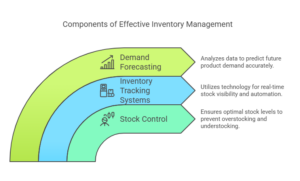Inventory management refers to a critical systematic process that enables businesses to optimize stock levels, reduce costs and ensure that products are available when customers need them, to achieve greater operational efficiency, and drive long-term success.
Key Components of Inventory Management
- Stock Control: Monitoring inventory levels ensures that the right amount of stock is available at all times. It includes tracking products as they move through the supply chain – from procurement to storage, and finally to the point of sale. Effective stock control helps prevent overstocking, which can lead to excess carrying costs, and understocking, which can result in lost sales and dissatisfied customers.
- Inventory Tracking Systems: Modern inventory management relies heavily on technology, including inventory tracking systems such as barcoding, RFID (Radio Frequency Identification), and inventory management software. These systems provide real-time visibility into stock levels, locations, and movements. They also enable businesses to automate routine tasks like reordering, thereby reducing manual errors and improving efficiency.
- Demand Forecasting: Crucial for effective inventory management, accurate demand forecasting involves analyzing historical sales data, market trends, and seasonal variations, to predict future demand for products. This foresight allows businesses to plan inventory purchases and production schedules more accurately, reducing the risk of stockouts or excess inventory. Advanced forecasting techniques may also incorporate machine learning algorithms to enhance prediction accuracy.

Benefits of Effective Inventory Management
Implementing a robust inventory management system offers numerous benefits, including:
- Improved cash flow – businesses can avoid tying up too much capital in unsold stock.
- Enhanced customer satisfaction – having the right products available at the right time can significantly boost customer loyalty and repeat business.
- Reduced storage costs and minimized waste – contributing to overall operational efficiency.
Challenges of Inventory Management
Despite its benefits, inventory management comes with its own set of challenges. These can include dealing with unpredictable demand, managing multi-channel inventory, and handling perishable goods. Moreover, businesses must continually adapt to changes in supply chain dynamics, such as supplier reliability or logistical disruptions. To mitigate these challenges, businesses should adopt flexible inventory management practices and leverage advanced technologies for better decision-making.


